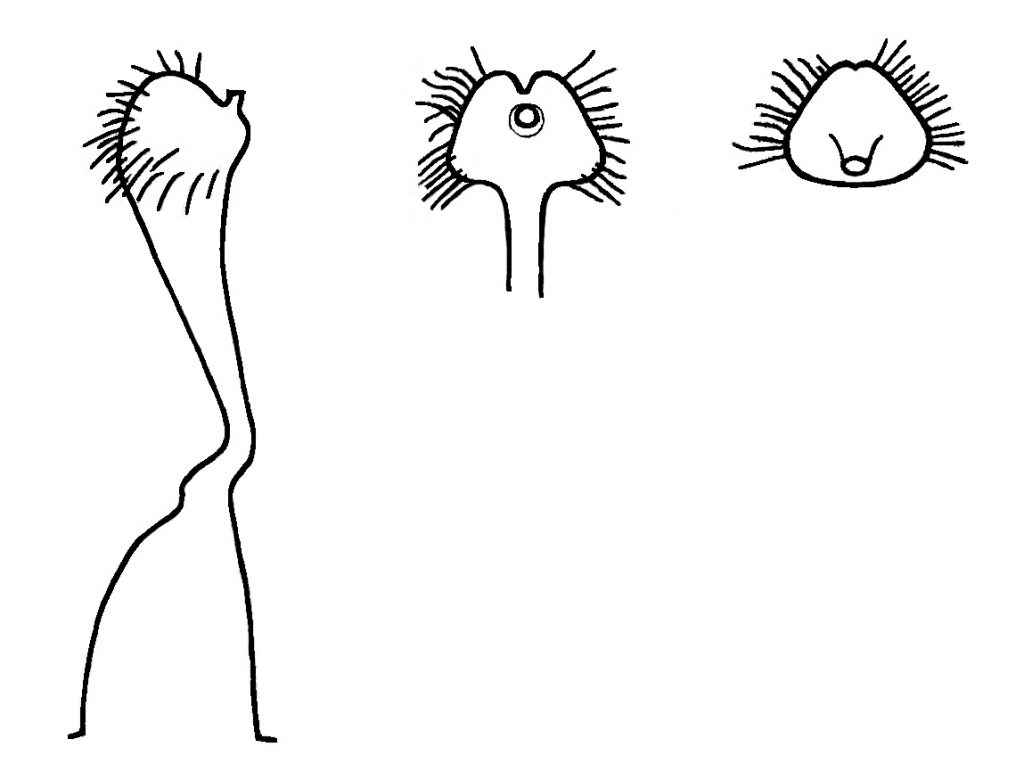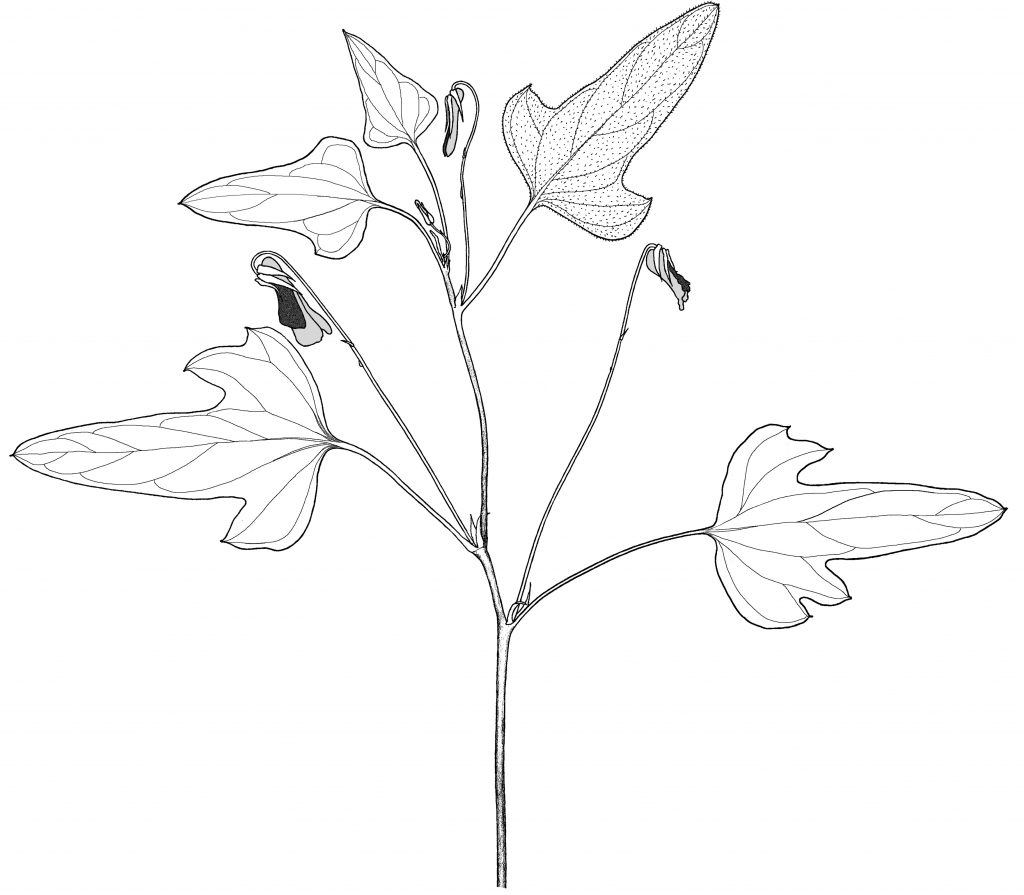
Viola lobata, Benth
Kim’s draft text, not in final form. Illustrations: 2 photographs of Viola lobata, 1 photograph of Viola lobata ssp integrifolia, 1 phtograph of Viola lobata ssp lobata, 3 drawings of Viola lobata and 1 drawing of a Viola lobata hybrid.
There is a variety of this violet usually growing with it, which has entire leaves but in all other respects is similar. This variety is appropriately called integrifolia, which means entire leaf. It illustrates what is called dimorphism (two forms) where the leaves of a species are lobed or dissected and those of its variety are not. The two forms hybridize and intergrade so intermediate forms are found.
This species displays dimorphism: V. lobata and its var. integrifolia Watson with almost deltoid leaves, as also occurs in two closely related eastern species of subsection Nudicaules: V. tripartita and V. hastata. Undivided leaf shapes of V. lobata and tripartita are very similar Both forms, divided and un-divided leaves, readily hybridize, resulting in a large number of intermediate forms between the two parents.
Plant 5–46 cm high, Top of rhizome 2.5 cm below ground pubescence variable, from dense pubescence throughout (both surfaces of lamina, veins, margins, sepals, auricles, stipules, top half of peduncle) to entirely glabrous. Usually single stemmed but may have up to three stems, erect, 6-15” high, Older plants have several stems. Stems glabrous, purple above ground, colourless below. Stem glabrous, purple above ground, colourless below. Remains of scarious stipule at base of stem at ground level and scar. A characteristic of Vv. purpurea, beckwithii, douglasii (?), hallii, cuneata, sheltonii. Stipules on base of stem scarious, brown or colourless, Caulescent perennial, no leaves on lower 3/4 of stem. Similar leafed V. lobata at O’Brien, had 1 cm of lower stem underground, but lower bract on stem was in same position just above ground level. Underground stem section was much thicker, 0.3 cm diam. Scarious bract or is it a stipule at base of vertical stem, all leaves borne near top of stem, Stem purple, glabrous, from spreading or erect fleshy rhizome with tough roots, top of rhizome 2.5-10 cm below ground level. Underground stem section often thicker, 0.3 cm diam. Stems glabrous or pubescent, purple above ground. In first year, one leaf only on a long petiole from rootstock. No cauline leaves on lower part (from 1/3 to 3/4 half) of stem (Nudicaules). On the lower stem, about or just above soil level, each stem has one bract, sometimes scarious, brown or colourless. Are these bracts or stipules? [Also a characteristic of V. purpurea, beckwithii, douglasii (?), hallii, cuneata, sheltonii].
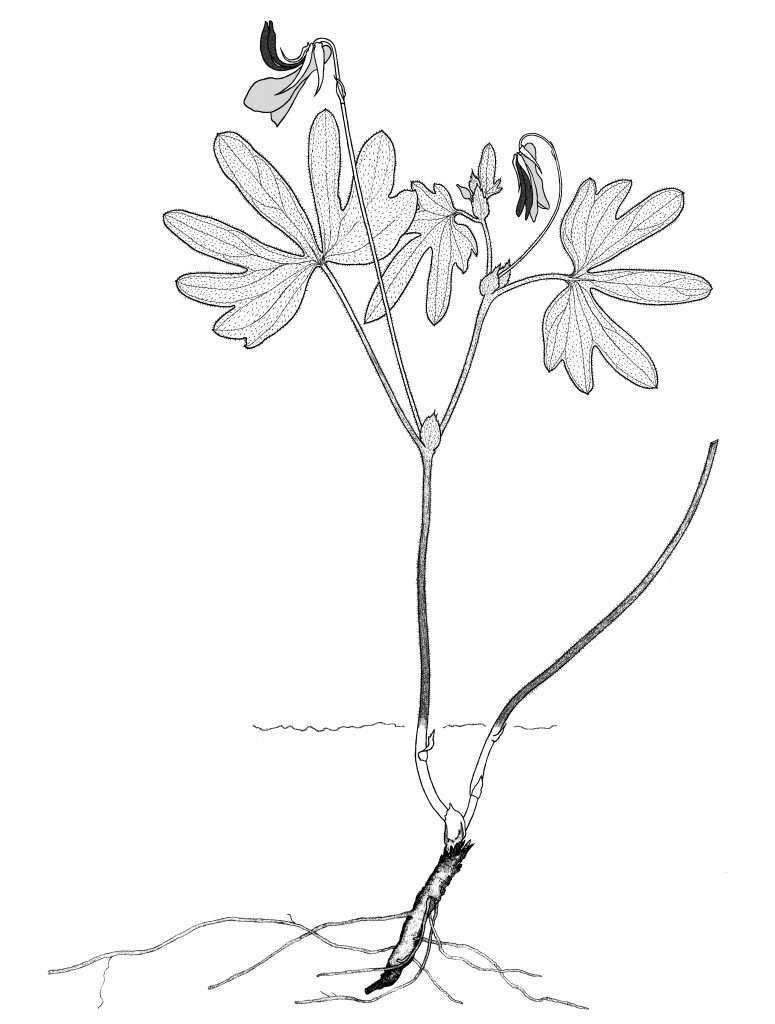
Leaves small to large in different populations, often glaucous, pale on lower surface; reniform, deltate, ovate, or diamond-shaped, cuneate base, divided into five to nine narrow, oblong lobes or segments, tips of all leaf segments are softly pointed with terminal dark gland, but Viola Brainerd-Baird says leaf lobes end in a tiny hard tip. I did not observe this. but no glands in axils of leaf lobes, glands on tip of each leaf lobe, segment margins entire to toothed, glabrous or hairy, 15-150 mm wide. Tips of all leaves soft pointed with terminal dark gland on tip. Leaf glabrous, paler under stems green plus purple on upper stem, purple lower, colourless underground, glabrous. Leaves small, lobes narrow, pubescent all over lamina, veins margins.Leaf base, truncate, cordate or reniform. Cauline stipules large, leaf-like, at times deeply cut, not adnate, glabrous, 0.7-1.2 cm long. Basal leaves usually absent, petiole 50–215 mm; cauline petioles about the length of the leaf, 10–50 mm. no basal leaves.; leaf and petiole glabrous, lower surface slightly paler green, Leaves very pubescent both surfaces, veins and margins. Leaves glabrous or pubescent. Stipules large, wide ovate with fimbriae on margin, not adnate, green plus purple, glabrous, 0.9-1.2 cm long. Stipules pubescent, older stipules only pubescent around margins, green plus purple. Cauline stipules green, glabrous, not adnate, 0.7-0.8 cm, Lowest stipule 0.5 cm long, upper cauline stipule 0.6 cm. Newer petioles pubescent, older petioles only pubescent near leaf, some all glabrous. Petiole glabrous, green.
Peduncles only from upper axils, unusually stiff and wiry, peduncles about the length of the leavesglabrous or pubescent, 20–130 mm; bracteoles 1/10 to 1/4 down, wrapping around peduncle, 0.3-6 cm long, green sometimes spotted red-purple, redder than peduncle, glabrous. Bracteoles 1/10 to 2.5/10 down, 0.6 cm, green plus purple, glabrous. Peduncle green plus purple at top, purple lower half, glabrous. Peduncle green plus little purple, glabrous except for a few hairs at op but on bud, peduncle pubescent above bracts. bracteoles 0.25 cm, green, glabrous, wrapping around peduncle, 0.5 cm apart, c. 2/5 down. Peduncles green, some with a little purple, glabrous; sepals and auricles green plus purple spotting, 1.2 cm; sepals long thin, tapered, narrow hyaline margins, very short hairs on margin; auricles short, glabrous, not appressed, uneven in size, sepals and auricles completely separate from each other, not overlapping.
Sepals and auricles 0.7-1.2 cm long, green or with red-spots on green; sepals long, tin, gradually tapered, narrow hyaline margins, very short hairs on margin or sometimes glabrous; auricles thick, short, glabrous, not appressed to peduncle, sepals and auricles completely separate from each other, not overlapping. sepals plus auricles 0.7 cm, green, sepals with short hairs around margin, tapered, hyaline margins, auricles green, glabrous, short not appressed to peduncle. On bud, sepals, auricles, peduncle top half only all very pubescent. sepals plus auricles 0.7 cm, green, glabrous, auricles almost even, same height, not appressed to peduncle, sepals tapered; petal spur pale yellow-green with strong ridge down middle, 0.15 cm long x 0.3 cm wide. smooth sepals and auricles wider, auricles standing free of peduncle, sepals short.
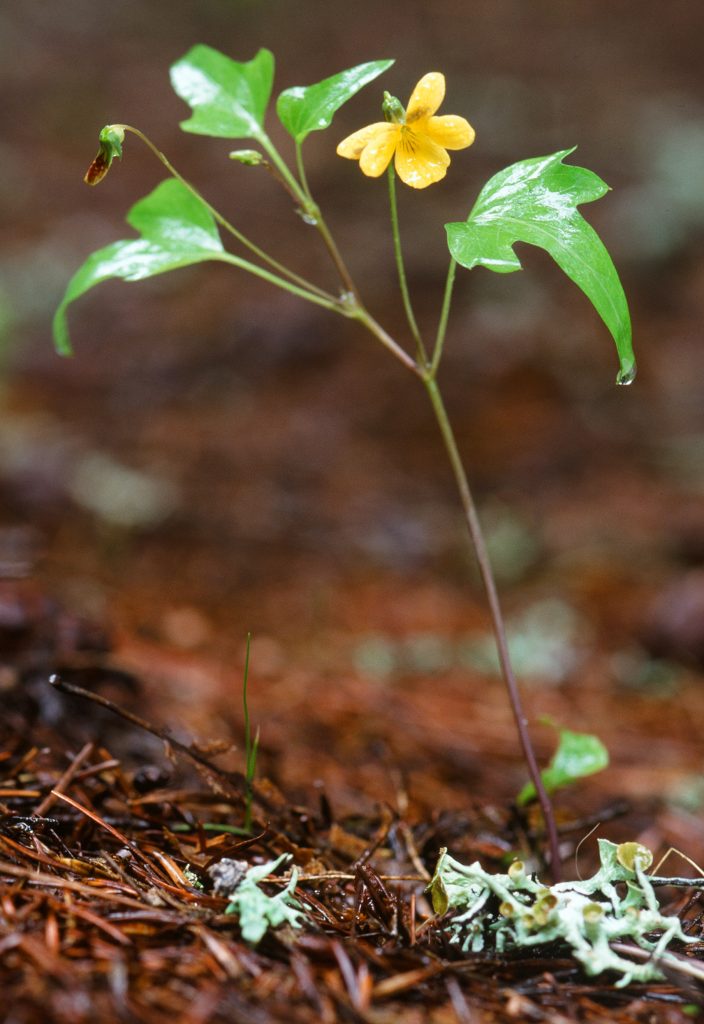
Flowers March to July.
Flowers 2.2 x 2.5 cm wide. flower 2.8 x 2.8 cm or some 3.0 cm wide x 2.8 high, Petals deep lemon yellow, thicker, more substantial than other violet species, inside surface all or lower 3 veined purple-brown toward base, purple veins show also on the outside of the three lower petals, red-purple veining heavy purple on back 2 top petals. Flowers rust colored on the back od the two upper petals and may have some of this color on the other petals too. The lines are brownish .All petals red-purple on reverse/outside. Little purple veining on back of two top petals and laterals. small black guidelines n laterals (x3) and spurred petal, spur pale yellow-green, 0.15 m long x 0.3 cm wide, small patch of dense fat clavate yellow hairs on lateral petals; Little purple on edge of top & lateral petals and at tip. upper 2 petals purple to red-purple outside and sometimes on other petals, dense, short, yellow, clavate hairs on inside of two lateral petals. Purple/brown dark guidelines on spurred petal inside half and a few on laterals. lowest petal (including spur) 8–19 mm; Spur pale yellow-green, 1.0-1.5 mm long X 3 mm wide. Spur pale yellow-green. spur yellow, Spur green, 0.1 cm long x 0.3 cm wide, Hairs on inside lateral petals, hairs short, clavate, dense. Flowers yellow. purple-brown on back two top petals, hairs on lateral petals inside are clavate, short, small patch, colourless, no perfume.
Ovary plus style 0.5 cm, ovary green, glabrous, style pale yellow-green, head of style papillose. Ovary plus style 0.45 cm, ovary glabrous, style pale green, head with notch in centre, papillose, small upturned beak of stigmatic opening. Two lobata specimens have emarginate top of stigma but one from Washington Ridge, east of Nevada City didn’t. No glands in between lobes of leaves, glands on every tip of lobes. Head of style papillose.
Pubescence of ovary and seed capsule variable from glabrous to pubescent, ovary plus style 0.45-0.5 mm high, head of style papillose, papillae in a ring around style head, top bald, hairs longer on lower side, stigmatic opening obvious in translucent style head (style head similar to V. glabella). Both Ezra Brainerd and Viola Brainerd Baird descriptions say hairs on the ovary, also the whole plant covered in hairs, leaves, stems, peduncles, stipules, but Jepson’s manual and my observations of several populations describe the ovary and seed pods as glabrous. Two V. lobata specimens have notch (emarginate) top of style but one from Washington Ridge, east of Nevada City, did not nor did cultivated plant from seeds ex Ron Ratko. Ovary plus style 0.5 cm, ovary pale green, glabrous, style colourless, style head pale green.
Seed capsule elliptical, 6–16 mm, green. Cleistogamous pods produced in summer in axils of upper leaves. Seeds 3.0-3.5 x 1.5-1.8 mm, dark rich, shiny brown, sometimes mottled.
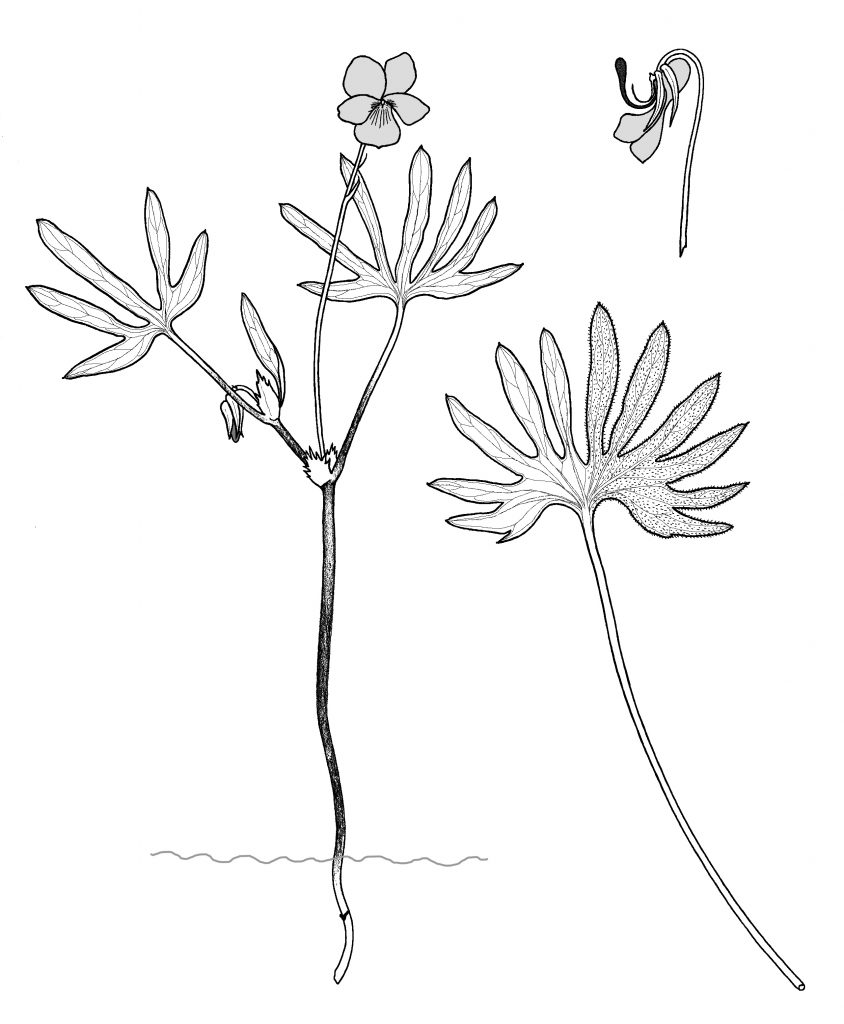
Habitat: V. lobata grows in open or shaded woodlands, forest duff or other rich, open, acid soil in part shade, in a well-drained area. frequently on dry slopes, on reddish-brown iron-rich soils, sometimes but not always derived from peridotite, an ultrabasic igneous rock. in rich leaf litter, ponderosa pines, over red clay soils, high iron, Though peridotite soils have low levels of available calcium they contain high concentrations of magnesium, iron, and some trace elements, particularly nickel and chromium. Soils developed from these rocks, and springs issuing from their fractures, tend to be highly alkaline. The soil can behave like a sponge; little springs and seeps are common. But there are also dry areas. Most plants cannot grow in these toxic soils; those that do either do not absorb the high levels of metals or have adapted to grow in their presence. The peridotite soils therefore are sparsely peppered with vegetation. The trees are typically dwarfed: incense cedar [Libocedrus decurrens], Jeffrey pine [Pinus jeffreyi] and manzanitas, the latter two having greyish foliage. metamorphic rocks (). Also growing in Nevada Co., California, Washington Ridge, 4,000 ft, 27 May 1998, in rich leaf litter, ponderosa pines, over red clay soils, high iron. 2000-6000 ft.
Jun 4: Eldorado County, California. Trees growing around the Ranger station are Redwood (Sequoia sempervirens), Jeffrey Pine (Pinus jefferyi), Douglas Fir (Pseudotsuga menziesii), Ponderosa pines (Pinus ponderosa), Red Fir (Abies magnifica), White Fir (Abies concolor), Sugar Pine (Pinus lambertiana) and Incense Cedar (Libocedrus decurrens). Altitude 1,520m,. Very sandy soil. Also growing in the same area were Viola adunca and Viola bakeri, the former was just beginning to flower when the other two species had been flowering for at least a week or more.
Found in rich leaf litter, ponderosa pines, over red clay soils, high iron, Metamorphic rocks (Eldorado county, CA).
V. lobata subspecies. lobata
Leaves: cauline blade generally wider than long, generally reniform to ovate or deltate, palmate-lobed or -dissected, lobes or segments 3–12, fine- or coarse-serrate to generally entire.
Distribution: Confined to Southern Oregon and Northern California, Cascade Range, Sierra Nevada, Peninsular Ranges, and n Baja, California, 150-2300m. (2-6,000 ft. check). Sonoma & Napa Counties, eg. Annadel State Park & Mt. St. Helena [SFO environs].
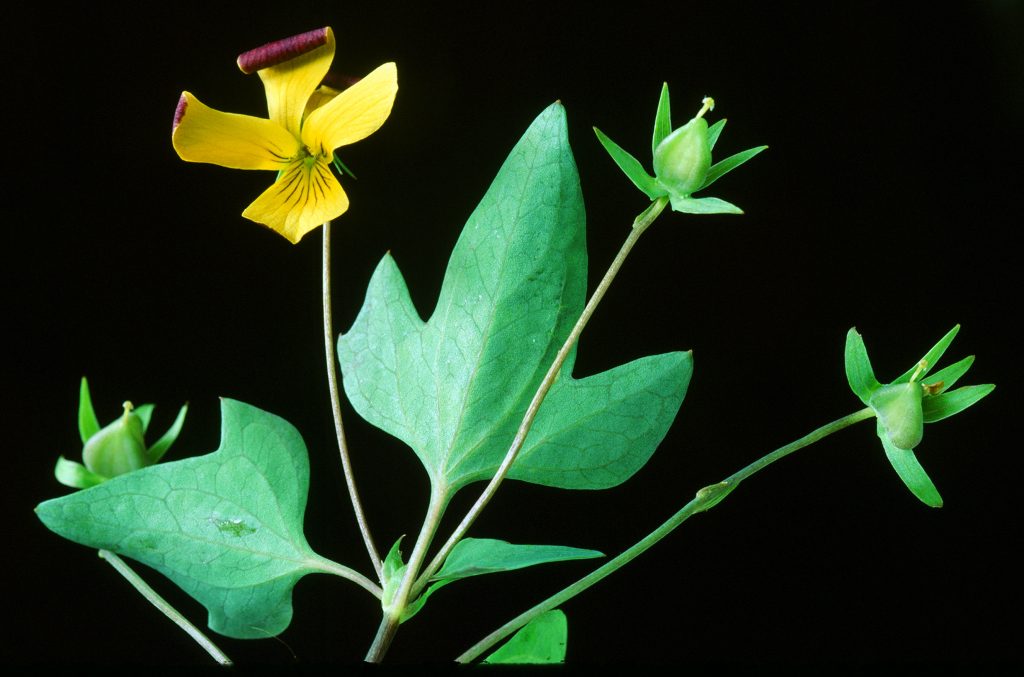
Ranges from the Yosemite Valley north to Nevada City, thence north to the contiguous counties of Plumas, Butte and Siskiyou and four miles north of California to Siskiyou, Oregon. also Tulare county. Road up Mt. Eddy, west of town of Mt. Shasta, California. All of the area of Mt. Eddy and Little Crater Lake is serpentine. Kalmiopsis Wilderness, west of O’Brien, Siskiyou Co., Oregon. Josephine Co. 1500’. Josephine County, OR
2June 1998, & 4 June 4, 2008, El Dorado Co., California, 5,000 ft (1,520 m): #1: Nevada Co., California, Washington Ridge, 4,000 ft, 27 May 1998.
Nomenclature and Taxonomy:
Sect. Chamaemelanium Ging., subsection Nudicaules [Marcussen, 2011].
Viola lobata Benth. Pl. Hartweg. 298. 1848.
First collected by Theodore Hartweg in Sacramento Mtns of California (Sierra foothills of Butte Co.,) in 1845.

subsp. integrifolia (S. Watson) R.J. Little
syn. var integrifolia S. Watson
Subsp. integrifolia collected by J G. Lemmon, June 1875, Mohawk Valley, Sierra Co., California. Collected also in 1934 at Mt. S. Helena, Napa County, California.
Also described in 1863 as (syn.)Viola sequoiensis Kellogg, collected Nevada City, Nevada Co., CA, but the ‘Sequoias’ were identified as firs.
There is a variety of this violet usually growing with it, which has entire leaves but in all other respects is similar. This variety is appropriately called integrifolia, which means entire leaf. It illustrates what is called dimorphism (two forms) where the leaves of a species are lobed or dissected and those of its variety are not. The two forms cross and intergrade so intermediate forms are found. Dimorphism is seen, also, in a yellow species found in the mountains of the Carolinas, V. tripartita, and its entire-leaved variety, glaberrima.
subsp. integrifolia (S. Watson) R.J. Little
Leaves: cauline blade diamond-shaped to generally deltate, entire to toothed
Uncommon. Habitats of the species, Northwestern California, Cascade Range, Sierra Nevada, Peninsular Ranges, 400–1700 m.
I saw Viola lobata subsp. integrifolia along the Ishy Pishy Road, near Orleans, in the Marble Mountains along the Klamath River, Siskiyou County, California, 1992. It was growing in a seep through a field of grasses and Iris tenax ssp. klamathensis. V. lobata ssp. lobata was growing nearby, also some hybrid plants with trilobed leaves.
Siskiyou Co., 1,000m, 28 May 1998: This plant has only minimal leaf divisions, similar to undivided leaf form seen in northern California (see slide) in field of mown irises. Young plants have only one leaf and petiole.
Diploid, 2n=2x=12. Chromosome analysis by Thomas Marcussen groups V. lobata closely with V. pubescens and tripartita.
